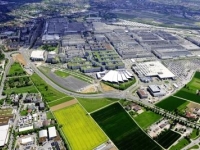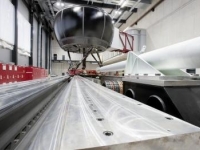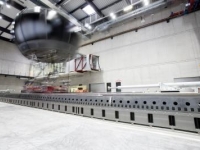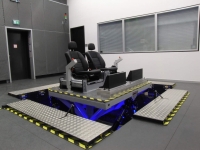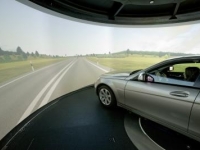Technology
Digital testing supplements real-life trials
The Driving Simulation Centre
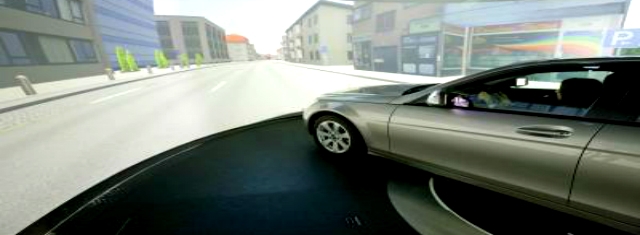
Driving simulator in Sindelfingen (Source: © 2015 Daimler AG. All rights reserved.)
USPA NEWS -
Mercedes-Benz opened the world's most cutting-edge "moving-base" driving simulator in Sindelfingen. With its 360° screen, fast electric power system and the twelve-metre-long rail for transverse or longitudinal movements.
With DYNAMIC SELECT, the handling characteristics of the new-generation A-Class can be altered instantaneously at the push of a button. DYNAMIC SELECT allows a particularly broad range of setting options in combination with the new suspension featuring the Adaptive Damping System. The suspension experts at Mercedes-Benz were already experimenting with the variance of the damping characteristics before an operational prototype was available: the so-called ride simulator at the development centre in Sindelfingen enabled virtual test drives to be carried out with the new suspension right from an early phase of the development process.
For the purposes of these early suspension tests, the engineers fed the so-called ride simulator at the development centre in Sindelfingen with the surface data from real-life test stretches and the corresponding suspension data of the Adaptive Damping System on the A-Class. In this way, it was possible to carry out virtual test drives with the new suspension using the two seats on the test rig right from an early phase of the development process.
Numerous simulators are employed as standard practice in the development and testing of new vehicles at Mercedes-Benz. "Digital prototypes" of a vehicle which are created with the aid of high-performance computers enable comprehensive testing of a new model in many driving situations before the actual vehicle exists in real life. As a result, the actual prototypes attain a higher maturity level more quickly, enabling even more detailed testing.
The best possible development results are obtained by intelligently combining state-of-the-art simulation methods with highly intensive practical trials covering many millions of kilometres. The latter remain an indispensable part of the development process. As such, simulation and simulators are no substitute for real-life tests, but rather serve to supplement these tests.
As a safety pioneer, Mercedes-Benz has always been a trailblazer in simulator technology. It was 30 years ago, on 10 May 1985, that the first driving simulator, developed in-house, was commissioned at the Daimler-Benz research centre in Berlin-Marienfelde. The motion system was unique in the automotive industry at the time. And Mercedes-Benz continues to lead the way in the field of simulators:
at the end of 2010, Mercedes-Benz opened the world's most cutting-edge "moving-base" driving simulator in Sindelfingen. With its 360° screen, fast electric power system and the twelve-metre-long rail for transverse or longitudinal movements, the dynamic driving simulator is the most powerful in the entire automotive industry. With this driving simulator, highly dynamic driving manoeuvres such as changing lane can be simulated in a realistic manner, enabling in-depth research into driver and vehicle behaviour on the road.
Numerous other simulators are used in the development and testing of new vehicles. With a ride simulator it is possible to carry out subjective assessments of the performance of digital prototypes driving on uneven roads, for example. To this end, the Mercedes specialists feed the simulator with the surface data of real-life test stretches and the necessary suspension and functional data relating to vehicle models. Driver and front passenger can sit in the two seats on the test rig to carry out purely digital yet realistic test drives, as the vehicle seats mounted on a hexapod with electrical actuators move as specified by the digital prototypes.
Fixed-base simulators do not have a hydraulically or electrically powered motion system and the vehicle cab is fixed to the floor. Thanks to single- or multi-channel projection and the sound systems conveying driving noises, the traffic scenario is nevertheless so realistic that the driver becomes immersed in the virtual world and behaves as if in real-life road traffic. The driving assistance systems are tested in different traffic situations here. Development work is also carried out on interior noise by reference to measured and synthetic noise and with the aid of expert panels and customer studies.
Finally, the assistance systems simulator based on an S-Class provides a realistic impression of active safety systems which are already in service on board production vehicles. The virtual test drive brings active safety vividly to life, providing the simulator's occupants with a swift and simple means of experiencing the current assistance systems interactively in different scenarios.
A key advantage of the Driving Simulation Center is that all the simulators are housed under the one roof. This enables highly cost- and time-efficient deployment for the specific purpose concerned. Also unique in the automotive sector is the Driving Simulation Centre's physical closeness to the other research and development areas in Sindelfingen, including the two climatic wind tunnels which went into service in 2011. These wind tunnels simulate extreme weather conditions.
Temperatures ranging from minus 40 to plus 60 degrees Celsius, hurricanes with wind speeds of up to 265 km/h, tropical downpours and heavy snowstorms are all part of the standard repertoire available to the test engineers. If needs be, they can even provide a realistic simulation of a mercilessly hot sun. The new climatic wind tunnels make it possible for the engineers to optimise new vehicles or components for all possible weather conditions at a very early stage of the development process.
This means that in future only prototypes which have thoroughly demonstrated a high degree of maturity in the face of the most adverse climatic influences will be released for subsequent real-life trials in the cold of the Arctic and the blistering heat of the desert.
Source: Daren Frankish Media | Daimler AG.
(Mercedes-Benz "moving-base" driving simulator in Sindelfingen)
Source: Daren Frankish Media | Daimler AG.
(Mercedes-Benz "moving-base" driving simulator in Sindelfingen)
more information: https://www.mercedes-benz.com/en/mercedes-benz/innovation/the-mercedes-benz-driving-simulation-center/
Liability for this article lies with the author, who also holds the copyright. Editorial content from USPA may be quoted on other websites as long as the quote comprises no more than 5% of the entire text, is marked as such and the source is named (via hyperlink).


